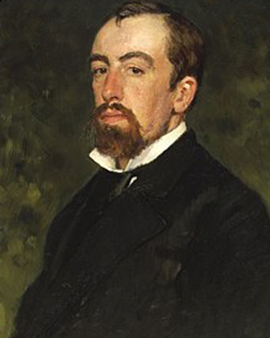


In the midst of the turbulent 19th century, on May 20, 1844, Vasily Dmitrievich Polenov saw the light of day in Saint Petersburg. As a member of a noble family with many children and the son of the historian, archaeologist and diplomat Dmitri Vasilyevich Polenov, he was embedded from the very beginning in an intellectual and knowledge environment that prepared him for his artistic path. Throughout the turmoil of Russian history, Polenov emerged as a painter and educator who captured the beauty of the world in unforgettable masterpieces - works that today enrich our collection of fine art prints.
Polenov's education began in Petrozavodsk, where he spent his school years. His artistic career began at the Petersburg Academy of Arts, where he laid the foundation of his creative work under the tutelage of Pavel Petrovich Chistyakov. After winning a gold medal for his painting "Job and His Friends" in 1869, he was honored again a year later for his work "Christ Raises the Daughter of Jairus." Polenov, always eager to expand his knowledge, in parallel completed his studies at the Law Faculty of St. Petersburg University. After completing his education, Polenov was drawn to the wider world. He traveled to Vienna, Munich, Venice, Florence and Naples and spent a long time in Paris, where he created his remarkable painting "The Arrest of the Countess d'Etremont". Yet despite his extensive travels, his heart remained firmly rooted in his native Russia. Upon his return in 1876, he volunteered for the Russo-Turkish War and served as the official court painter at the headquarters of Tsar Alexander III.
In the years that followed, Polenov's artistic career took off. After the war, he settled in Moscow and in 1884 undertook another extended trip that took him through Istanbul, Palestine, Syria, and Egypt. Upon his return to Russia, he became a member of the Peredvizhniki, the Association of Artists of the Traveling Exhibitions. However, Polenov's abilities were not limited to painting. From the 1870s he also turned to designing theater decorations, uniquely combining art and theater. Polenow was not only a visionary painter, but also a dedicated educator. From 1882 to 1895, he taught at the Moscow College of Painting, Sculpture and Architecture, where he influenced a new generation of artists such as Isaak Ilyich Levitan and Konstantin Alekseevich Korovin. Polenov died in 1927 in the picturesque village of Borok in Tula Oblast. He left behind an impressive body of work devoted primarily to history painting, landscape painting, and genre painting. His tireless contribution to the art world remains unforgotten and lives on in the art prints that we produce with the utmost care and dedication to do justice to the spirit of this great artist.

In the midst of the turbulent 19th century, on May 20, 1844, Vasily Dmitrievich Polenov saw the light of day in Saint Petersburg. As a member of a noble family with many children and the son of the historian, archaeologist and diplomat Dmitri Vasilyevich Polenov, he was embedded from the very beginning in an intellectual and knowledge environment that prepared him for his artistic path. Throughout the turmoil of Russian history, Polenov emerged as a painter and educator who captured the beauty of the world in unforgettable masterpieces - works that today enrich our collection of fine art prints.
Polenov's education began in Petrozavodsk, where he spent his school years. His artistic career began at the Petersburg Academy of Arts, where he laid the foundation of his creative work under the tutelage of Pavel Petrovich Chistyakov. After winning a gold medal for his painting "Job and His Friends" in 1869, he was honored again a year later for his work "Christ Raises the Daughter of Jairus." Polenov, always eager to expand his knowledge, in parallel completed his studies at the Law Faculty of St. Petersburg University. After completing his education, Polenov was drawn to the wider world. He traveled to Vienna, Munich, Venice, Florence and Naples and spent a long time in Paris, where he created his remarkable painting "The Arrest of the Countess d'Etremont". Yet despite his extensive travels, his heart remained firmly rooted in his native Russia. Upon his return in 1876, he volunteered for the Russo-Turkish War and served as the official court painter at the headquarters of Tsar Alexander III.
In the years that followed, Polenov's artistic career took off. After the war, he settled in Moscow and in 1884 undertook another extended trip that took him through Istanbul, Palestine, Syria, and Egypt. Upon his return to Russia, he became a member of the Peredvizhniki, the Association of Artists of the Traveling Exhibitions. However, Polenov's abilities were not limited to painting. From the 1870s he also turned to designing theater decorations, uniquely combining art and theater. Polenow was not only a visionary painter, but also a dedicated educator. From 1882 to 1895, he taught at the Moscow College of Painting, Sculpture and Architecture, where he influenced a new generation of artists such as Isaak Ilyich Levitan and Konstantin Alekseevich Korovin. Polenov died in 1927 in the picturesque village of Borok in Tula Oblast. He left behind an impressive body of work devoted primarily to history painting, landscape painting, and genre painting. His tireless contribution to the art world remains unforgotten and lives on in the art prints that we produce with the utmost care and dedication to do justice to the spirit of this great artist.
Page 1 / 1






